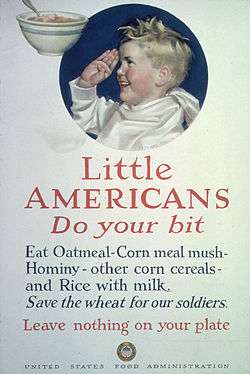Hasty pudding
|
"Little Americans. Do Your Bit. Eat Oatmeal- Corn meal mush- Hominy - other corn cereals- and rice with milk. Save the Wheat for our Soldiers. Leave Nothing On Your Plate.", (U.S. Food Administration. Educational Division. Advertising Section, ca. 1918) | |
| Type | Pudding or porridge |
|---|---|
| Place of origin | United Kingdom |
| Main ingredients | Grains, milk or water |
|
| |
Hasty pudding is a pudding or porridge of grains cooked in milk or water. In the United States, it often refers to a version made of ground corn. Hasty pudding is notably mentioned in a verse of the early American song Yankee Doodle.
In Britain
Since the 16th century at least, hasty pudding has been a British dish of wheat flour cooked in boiling milk or water until it reaches the consistency of a thick batter or an oatmeal porridge.[1] Hasty pudding was used as a term for the latter by Hannah Glasse in The Art of Cookery (1747). "Hasty-pudding" is also mentioned in Samuel Johnson's Dictionary of 1755 as a combination of either milk and flour or oatmeal and water.
In North America
North American recipes include wheat, oat, and corn-based puddings.
Eliza Leslie's recipes
Eliza Leslie, an influential American cookbook author of the early 19th century, includes a recipe for flour hasty pudding in her 1840 Directions for Cookery, In Its Various Branches, and calls the corn type "Indian mush." She calls an oatmeal version burgoo. She stresses the need for slow cooking rather than haste, and also recommends the use of a special mush-stick for stirring to prevent lumps. (This mush-stick is perhaps related to the spurtle, or the pudding stick of the nursery rhyme beating.)
Corn or Indian mush
A North American version, known as corn mush or Indian mush, is in its simplest form corn meal cooked slowly in water until it thickens. Like grits or polenta, it may be eaten hot, or left to cool and solidify, when slices of the cold pudding may then be fried. This hasty pudding was once a popular American food because of its low cost, long shelf life, and versatility, and was eaten with both sweet and savory accompaniments, such as maple syrup, molasses, or salted meat.
Indian pudding
Indian pudding is a traditional New England dessert, "a cold-weather classic."[2] Seventeenth-century English colonists brought hasty pudding to North America and transformed it completely. Lacking wheat, they substituted cornmeal, a grain they learned to cultivate from the indigenous peoples, which led to the new name Indian pudding, derived from their name for cornmeal, Indian meal.[3] They substituted milk, which was plentiful, for water and added locally available sweeteners, either molasses or maple syrup, and spices when available, typically cinnamon and ground ginger. Other traditional ingredients include butter and eggs for a smoother consistency and raisins and nuts for flavor and contrasting texture. Finally, Indian pudding is baked in a slow oven for several hours, transforming its texture from the porridge-like quality of hasty pudding to a smoother texture more typical of custard puddings. According to Kathleen Wall, Plimoth Plantation's expert on colonial cooking, "The longer it cooks, the more liquid the gritty cornmeal absorbs, and the more it absorbs, the smoother the texture of your pudding."[2] It was commonplace in the colonial era and enjoyed a revival as part of Thanksgiving Day celebrations in the late 19th century. It was found in most American cookbooks before 1900.[4] The 20th century’s commercial puddings with their industrially perfect smooth consistency displaced Indian pudding, and its cooking time had little appeal for the modern home cook. It is still associated with autumn holidays and occasionally revived by restaurants.[3] It is usually served warm and sometimes accompanied by vanilla ice cream or whipped cream.[5]
In "Yankee Doodle"
Hasty pudding is referred to in a verse of the early American song "Yankee Doodle":
Fath'r and I went down to camp
Along with Captain Goodin',[1]
And there we saw the men and boys
As thick as hasty puddin'
- ^ "Goodin" is a New England pronunciation of Goodwin
Similar dishes
Polenta is the Italian version of hasty pudding, with maize/corn substituted for the wheat originally used by the Romans and mămăligă is the Romanian version, also made with maize. While Serbia also has a maize-made dish similar to polenta and mămăligă, called kačamak (качамак), it also has a traditional hasty pudding dish made of fine wheat flour cooked with milk called mlečnjak (млечњак), as well as the standard grits cooked in milk called griz (гриз), introduced from the West in the 1890s.
In the recipe for the Brazilian pudding curau (Portuguese pronunciation: [kuˈɾaw]), sweet corn grains are taken raw together with milk and most often coconut milk to a blender until uniformly liquid, then cooked until it becomes thick (shredded coconut might be added in the last minutes), with cinnamon powder sprinkled at the end.
See also
References
Notes
- ↑ Oxford English Dictionary, s.v. hasty pudding
- 1 2 Seavey, Aimee (September 2012). "The Encyclopedia of Fall: I is for Indian Pudding". Yankee Magazine. Retrieved 30 May 2013.
- 1 2 Weiss, Laura B. (12 November 2012). "Looks Aren't Everything: An Ode to Indian Pudding". Saveur. Retrieved 30 May 2013.
- ↑ Young, John Edward (15 November 2006). "As American as ... Indian pudding". Christian Science Monitor. Retrieved 30 May 2013.
- ↑ "Plimoth Plantation's Slow-Cooker Indian Pudding". Yankee Magazine. Retrieved 30 May 2013.
Sources
- Evan Jones, American Food: The Gastronomic Story (1981) Viking Books ISBN 0-394-74646-5
- Jonathan Norton Leonard, American Cooking: New England (1970) Time-Life Books
